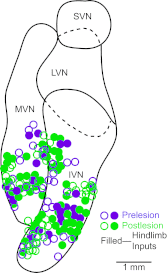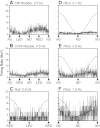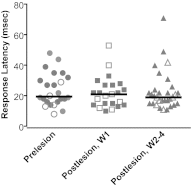Responses of vestibular nucleus neurons to inputs from the hindlimb are enhanced following a bilateral labyrinthectomy
- PMID: 23305979
- PMCID: PMC3615601
- DOI: 10.1152/japplphysiol.01389.2012
Responses of vestibular nucleus neurons to inputs from the hindlimb are enhanced following a bilateral labyrinthectomy
Abstract
Vestibular nucleus neurons have been shown to respond to stimulation of afferents innervating the limbs. However, a limitation in the potential translation of these findings is that they were obtained from decerebrate or anesthetized animals. The goal of the present study was to determine whether stimulation of hindlimb nerves similarly affects vestibular nucleus neuronal activity in conscious cats, and whether the responsiveness of neurons to the stimuli is altered following a bilateral labyrinthectomy. In labyrinth-intact animals, the firing rate of 24/59 (41%) of the neurons in the caudal vestibular nucleus complex was affected by hindlimb nerve stimulation. Most responses were excitatory; the median response latency was 20 ms, but some units had response latencies as short as 10 ms. In the first week after a bilateral labyrinthectomy, the proportion of vestibular nucleus neurons that responded to hindlimb nerve stimulation increased slightly (to 24/55 or 44% of units). However, during the subsequent postlabyrinthectomy survival period, the proportion of vestibular nucleus neurons with hindlimb inputs increased significantly (to 30/49 or 61% of units). Stimuli to hindlimb nerves needed to elicit neuronal responses was consistently over three times the threshold for eliciting an afferent volley. These data show that inputs from hindlimb afferents smaller than those innervating muscle spindles and Golgi tendon organs affect the processing of information in the vestibular nuclei, and that these inputs are enhanced following a bilateral labyrinthectomy. These findings have implications for the development of a limb neuroprosthetics device for the management of bilateral vestibular loss.
Figures







Similar articles
-
Vestibular nucleus neurons respond to hindlimb movement in the decerebrate cat.J Neurophysiol. 2014 Jun 15;111(12):2423-32. doi: 10.1152/jn.00855.2013. Epub 2014 Mar 26. J Neurophysiol. 2014. PMID: 24671527 Free PMC article.
-
Integration of vestibular and hindlimb inputs by vestibular nucleus neurons: multisensory influences on postural control.J Neurophysiol. 2021 Apr 1;125(4):1095-1110. doi: 10.1152/jn.00350.2019. Epub 2021 Feb 3. J Neurophysiol. 2021. PMID: 33534649 Free PMC article.
-
Vestibular nucleus neurons respond to hindlimb movement in the conscious cat.J Neurophysiol. 2016 Oct 1;116(4):1785-1794. doi: 10.1152/jn.00414.2016. Epub 2016 Jul 20. J Neurophysiol. 2016. PMID: 27440244 Free PMC article.
-
Integration of nonlabyrinthine inputs by the vestibular system: role in compensation following bilateral damage to the inner ear.J Vestib Res. 2009;19(5-6):183-9. doi: 10.3233/VES-2009-0337. J Vestib Res. 2009. PMID: 20495235 Free PMC article. Review.
-
Otolith and canal integration on single vestibular neurons in cats.Exp Brain Res. 2005 Jul;164(3):271-85. doi: 10.1007/s00221-005-2341-7. Epub 2005 Jul 1. Exp Brain Res. 2005. PMID: 15991028 Review.
Cited by
-
Time Course of Sensory Substitution for Gravity Sensing in Visual Vertical Orientation Perception following Complete Vestibular Loss.eNeuro. 2020 Jul 13;7(4):ENEURO.0021-20.2020. doi: 10.1523/ENEURO.0021-20.2020. Print 2020 Jul/Aug. eNeuro. 2020. PMID: 32561572 Free PMC article.
-
Eye Movements Are Correctly Timed During Walking Despite Bilateral Vestibular Hypofunction.J Assoc Res Otolaryngol. 2017 Aug;18(4):591-600. doi: 10.1007/s10162-017-0626-8. Epub 2017 Jun 7. J Assoc Res Otolaryngol. 2017. PMID: 28593438 Free PMC article.
-
Hindlimb movement modulates the activity of rostral fastigial nucleus neurons that process vestibular input.Exp Brain Res. 2015 Aug;233(8):2411-9. doi: 10.1007/s00221-015-4311-z. Epub 2015 May 15. Exp Brain Res. 2015. PMID: 25976518 Free PMC article.
-
Vestibular nucleus neurons respond to hindlimb movement in the decerebrate cat.J Neurophysiol. 2014 Jun 15;111(12):2423-32. doi: 10.1152/jn.00855.2013. Epub 2014 Mar 26. J Neurophysiol. 2014. PMID: 24671527 Free PMC article.
-
Descending Influences on Vestibulospinal and Vestibulosympathetic Reflexes.Front Neurol. 2017 Mar 27;8:112. doi: 10.3389/fneur.2017.00112. eCollection 2017. Front Neurol. 2017. PMID: 28396651 Free PMC article. Review.
References
-
- Anastasopoulos D, Mergner T. Canal-neck interaction in vestibular nuclear neurons of the cat. Exp Brain Res 46: 269–280, 1982 - PubMed
-
- Andersson G, Oscarsson O. Climbing fiber microzones in cerebellar vermis and their projection to different groups of cells in the lateral vestibular nucleus. Exp Brain Res 32: 565–579, 1978 - PubMed
-
- Baker J, Goldberg J, Hermann G, Peterson B. Spatial and temporal response properties of secondary neurons that receive convergent input in vestibular nuclei of alert cats. Brain Res 294: 138–143, 1984 - PubMed
Publication types
MeSH terms
Grants and funding
LinkOut - more resources
Full Text Sources
Other Literature Sources
Miscellaneous

